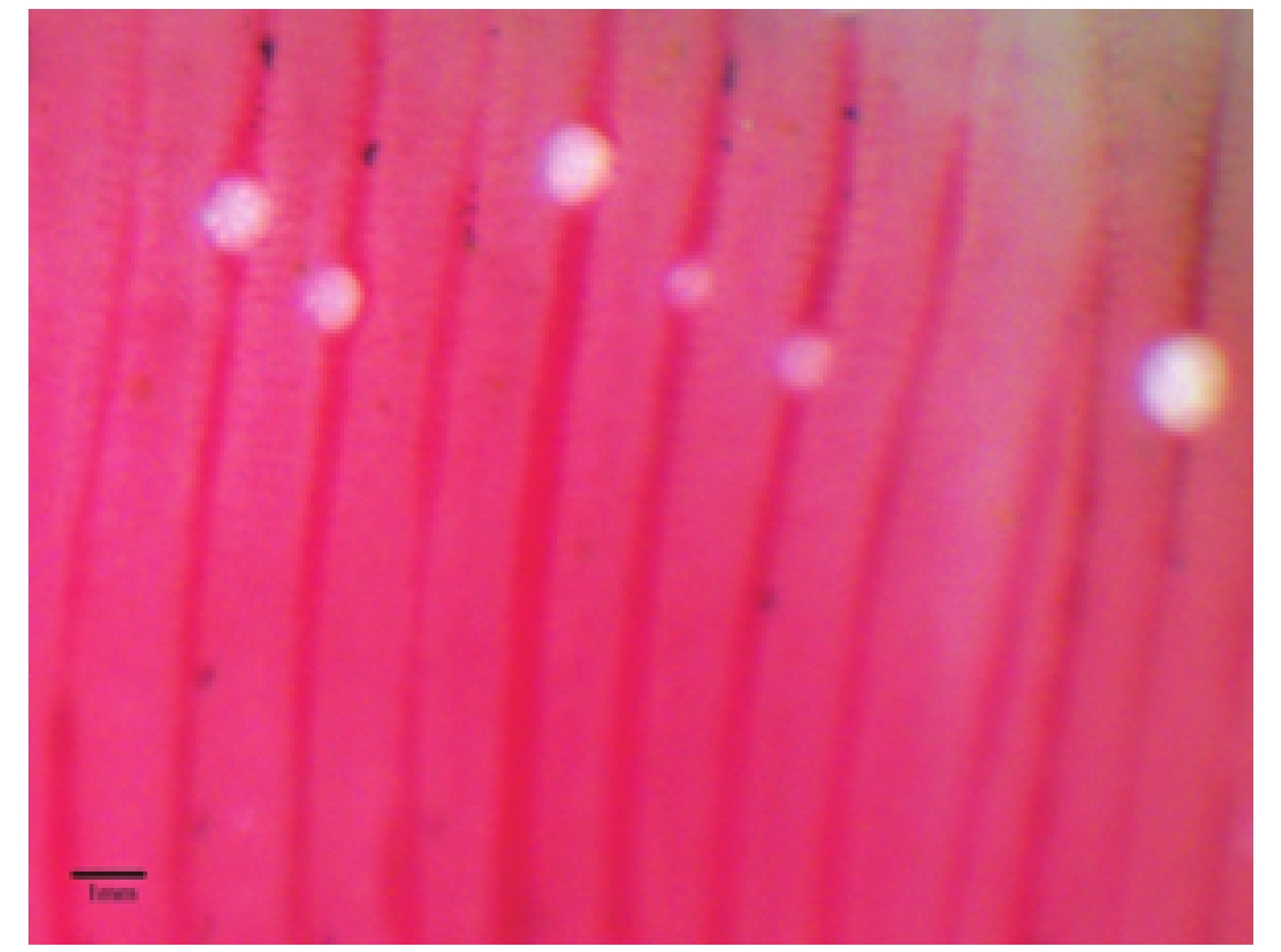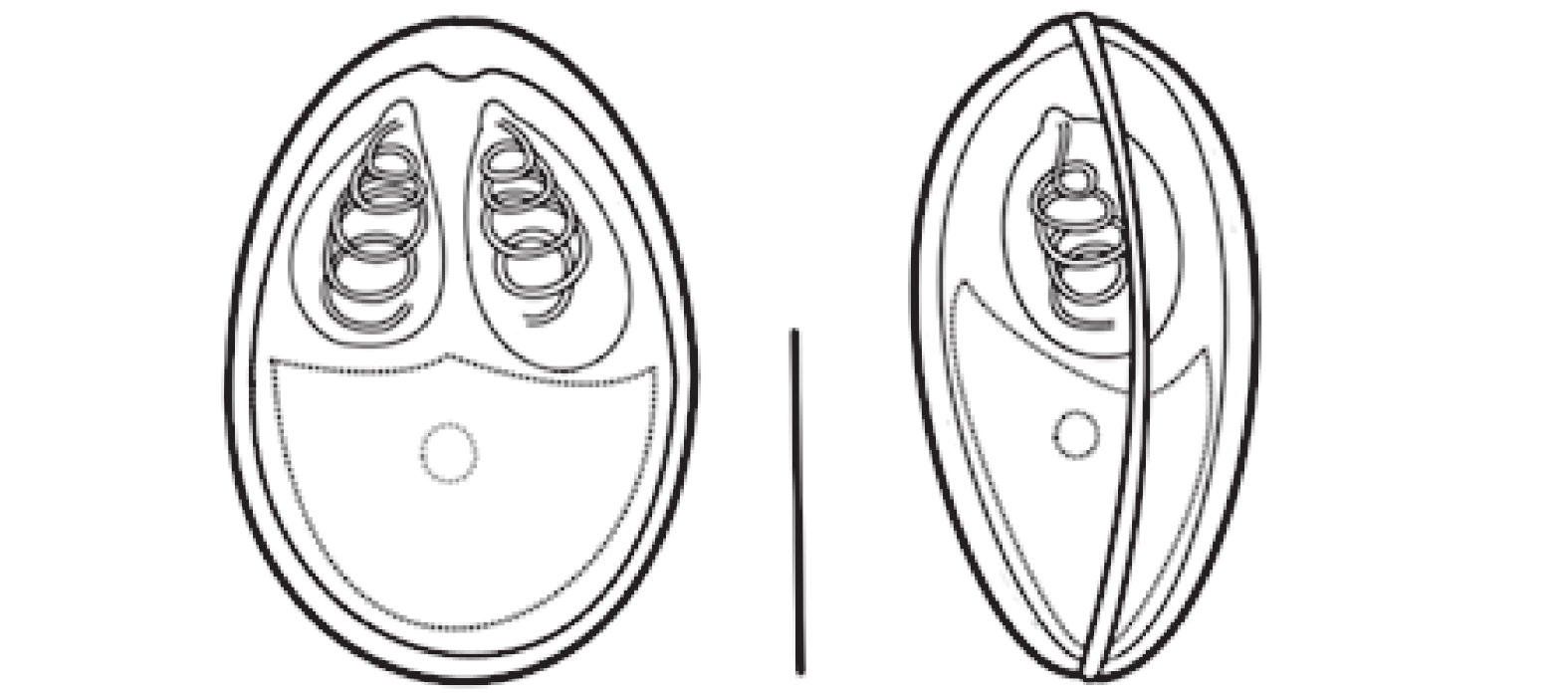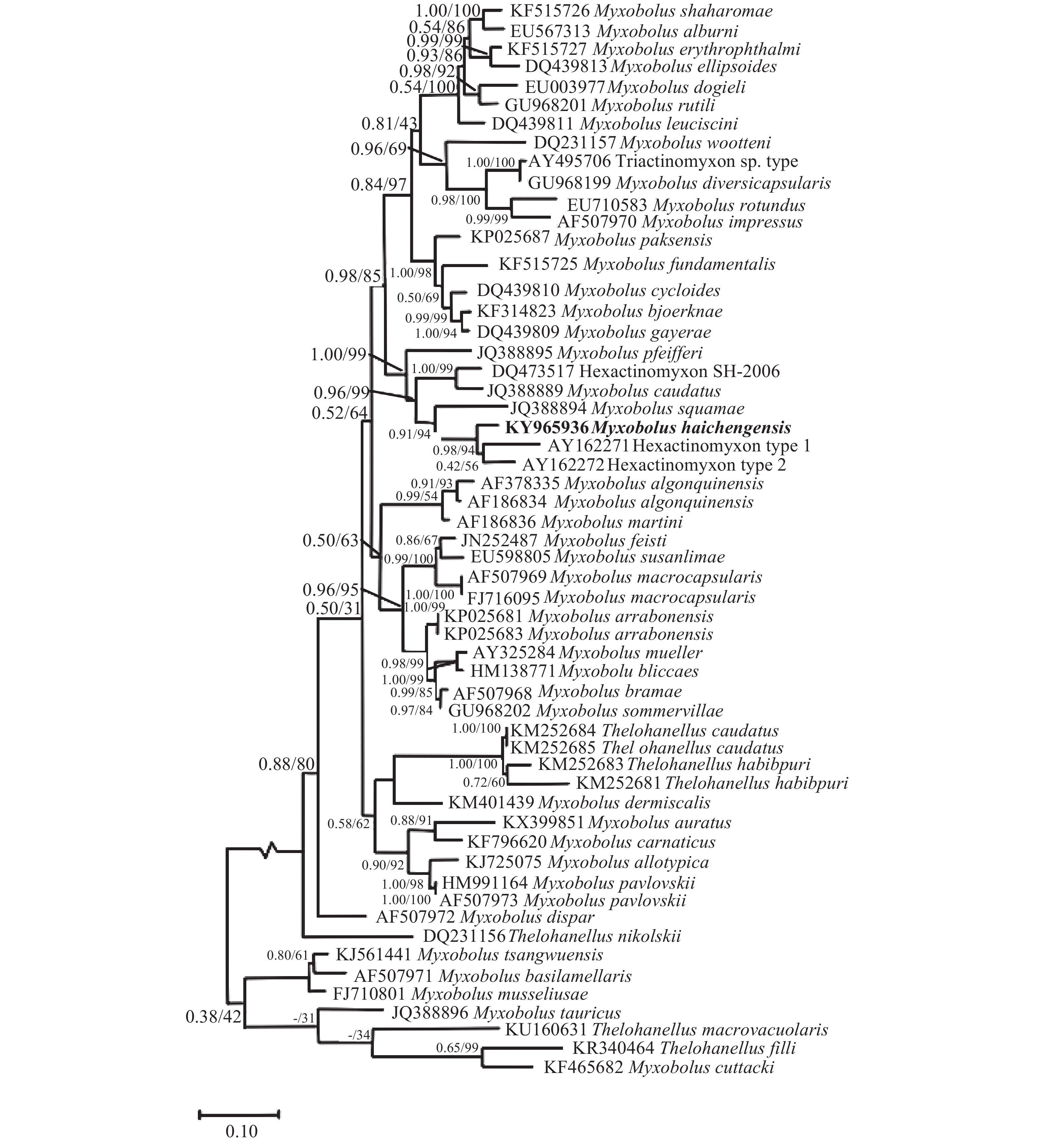SUPPLEMENTAL DESCRIPTION OF MYXOBOLUS HAICHENGENSIS CHEN, 1958 (MYXOZOA: MYXOSPOREA) INFECTING THE GILLS OF ABBOTTINA RIVULARIS BASILEWAKY: MORPHOLOGICAL AND MOLECULAR DATA
-
Abstract: Myxobolus haichengensis Chen, 1958 forms numerous small plasmodia on the gill filaments of wild cyprinid Abbottina rivularis Basilewaky. The species described originally was lacking important characters, which made the accurate identification difficult. Here, we supplemented its characteristics with morphological and molecular data. Plasmodia of M. haichengensis are oval. Mature spores are ellipsoidal-shaped in frontal view and fusiform-shaped in lateral view, measuring (10.8±0.7) μm (10.1—11.5 μm) long, (8.1±0.5) μm (7.5—9.0 μm) wide, and (5.7±0.4) μm (5.2—9.0 μm) thick; two unequal polar capsule are pyriform with tapering anterior, large polar capsule averaging (4.7±0.5) μm (4.8—6.7 μm) long and (2.5±0.2) μm (3.2—4.3 μm) wide; small polar capsule averaging (4.4±0.2) μm (4.1—4.8 μm) long and (2.2±0.1) μm (2.0—2.5 μm) wide; polar filaments coil with four to five turns. The nuclear 18S rDNA sequence was obtained and deposited in GenBank (KY965936), and sequences alignment analyses revealed that M. haichengensis was most similar with the actinosporean Hexactinomyxon type 2 (AY162272, 97%) released from the freshwater tublificid oligochaete Limnodrilus hoffmeisteri.
-
Keywords:
- Myxobolus haichengensis /
- Gill /
- Abbottina rivularis
摘要: 海城碘泡虫原始描述中形态数据较为简单,且存在多个宿主及寄生部位,其有效性有待确定。利用现行主流的黏孢子虫形态特征和基因标记系统分析相结合的分类学方法,对采自太湖棒花鱼鳃丝的海城碘泡虫进行了补充描述。该碘泡虫孢囊呈白色,圆形,大小为(0.6—1.1) mm。成熟孢子正面观近似椭圆形,上端稍尖,侧面观呈纺锤型,孢子长(10.8±0.7) μm (10.1—11.5 μm),孢子宽:(8.1±0.5) μm (7.5—9.0 μm),孢子厚:(5.7±0.4) μm (5.2—9.0 μm);两极囊呈梨形,大小存在细微差别,极囊顶端存在突起,大极囊长:(4.7±0.5) μm (4.8—6.7 μm),宽:(2.5±0.2) μm (3.2—4.3 μm),小极囊长:(4.4±0.2) μm (4.1—4.8 μm),宽:(2.2±0.1) μm (2.0—2.5 μm);极丝盘绕4—5圈。基于18S rDNA序列(GenBank登录号:KY965936)比对分析,该碘泡虫与放射孢子虫Hexactinomyxon type 2相似率最高,为97%。系统发育分析表明,该碘泡虫与Hexactinomyxon type 2、Hexactinomyxon type 1、Hexactinomyxon type SH-2006、Myxobolus pfeifferi、Myxobolus caudatus和Myxobolus squamae聚为独立分支,和其他已报道的黏孢子虫亲缘关系较远。研究在补充了海城碘泡虫形态学、基因标记序列信息基础上,推断了该虫生活史。 -
Myxozoans are microscopic, multicellular, and obligate endoparasitic cnidarians that mostly infect fish, with some species parasitizing amphibians, reptiles, birds and mammals[1]. Until now, approximately 2200 myxosporean species classified in 60 genera have been reported over the world[2]. However, some of them were originally described a long time ago with incomplete data, which makes the current evaluation of species diversity difficult[3—5]. To settle the above conundrum, a comprehensive approach integrating morphological, histological (organ or tissue tropism), molecular (DNA sequence) data for characterizing myxosporean species has been widely accepted and implemented[6, 7].
Abbottina rivularis Basilewaky (Cypriniformes: Cyprinidae), is a small benthopelagic freshwater cyprinid, and widely distributes in East Asia[8]. Up to now, 28 nominal myxosporean species were recorded from A. rivularis and its congeneric species in China: 2 of Chloromyxum, 3 of Zschokkella, 5 of Chloromyxu, and 18 of Myxobolus[5]. However, most of them were lack of molecular data. During the recent parasitological investigation, numerous plasmodia were found on the gills of A. rivularis in the Taihu Lake. Strict morphological comparisons showed that the spores were consistent with Myxobolus haichengensis Chen, 1958. According to the literature, M. haichengensis Chen, 1958 was first discovered on the gills of A. rivularis and Pelteobagrus fulvidraco, from the lower reach of the Liao River in Haicheng, Liaoning Province, China. The original morphological descriptions were somewhat ambiguous and incomplete, attributing to that the mature plasmodia and trophozoite were not observed. In the present study, we supplement the characteristics of M. haichengensis with morphological and 18S rDNA sequence data based on newly collected specimens.
1. Material and methods
1.1 Samples collection
In July 2016, twenty A. rivularis, body length of 73 —112 mm, were netted from the Lake Taihu, Wuxi, China (31°51′N, 120°23′E). All fishes were transported alive to the laboratory.
Gross examinations of all organs were conducted according to Lom and Dyková (1992)[9]. Numerous plasmodia containing myxospores were found on the gills of A. rivularis. Five plasmodia were isolated separately from the infected gill filaments, squeezed on a clean slide to make wet-mount slide, and observed under light microscope Olympus CX-31 equipped with digital camera. The spores on the slide were collected and used for molecular analyses. Measurements were performed on 50 fresh mature spores. All measurements are given in micrometers (μm, mean±SD) unless otherwise indicated. Line drawings of the myxospores were made based on the digitized images.
1.2 DNA isolation and sequencing
Genomic DNA was extracted using a QIAamp® DNA Micro Kit (Qiagen, Germany) according to the manufacturer’s instructions. The 18S rDNA was amplified with primers ERI-B1 and ERI-B10[10]. The PCR products were purified using a Sangon Biotech® sanorep Column DNA Extraction kit. The purified product was cloned into the pMD18-T vector (TaKaRa Qingdao, China), and 5 positive clones were sequenced with an ABI 3100 Genetic Analyzed automated DNA sequencer (Applied Biosystems).
Sequences were assembled and inspected with SeqMan (Lasergen package; DNAStar Inc., Madison, WI). Assembled sequence was deposited in GenBank (accession number KY965936) and verified by BLAST search. 56 sequences with high similarity were downloaded from GenBank and aligned using Clustal X 1.8 program with defaulting setting[11]. The alignment was corrected manually using the MEGA7.0 software[12].
1.3 Phylogenetic analyses
Phylogenetic analyses were conducted with Bayesian inference (BI) and maximum likehood (ML) methods. The appropriate nucleotide substitution model (GTR+G) was estimated with the lowest BIC (Bayesian Information Criterion) scores with software MEGA 7.0. Nucleotide frequencies were estimated from the data (A=0.255, T=0.266, C=0.198, G=0.281), six rates of nucleotide substitution were [AC]=0.089, [AG]=0.250, [AT]=0.127, [CG]=0.070, [CT]=0.355, [GT]=0.107. The proportion of invariable site was 0.35, and the alpha value of gamma distribution parameter was 0.38. ML phylogenetic trees were inferred with MEGA 7.0, and branch support was computed with 1000 replicates of bootstrap analyses. Bayesian analyses were conducted in software MrBayes ver. 3.1.2 with parameter setting nruns=4, nst=6, rates=invagamma, ngen=5000000. Posterior probability values were used as support for the Bayesian topology.
2. Results
Numerous plasmodia were generally found in the gill filaments of 7 (35%) out of the 20 examined Abbottina rivularis (Fig. 1). No other organs exa mined had plasmodia. Plasmodia were oval, measuring (0.6—1.1) mm in diameter (n=10) (Fig. 1).
2.1 Description of Myxobolus haichengensis
Fresh spores ellipsoidal-shaped in frontal view, and fusiform-shaped in lateral view, measuring 10.8±0.7 (10.1—11.5) μm long, 8.1±0.5 (7.5—9.0) μm wide (n=40), 5.7±0.4 (5.2—9.0) μm thick (n=10) (Fig. 2C, D; Fig. 3). Spore surface smooth, spore valves symmetrical. Two unequal polar capsules pyriform with an apophysis at the top end, and 4—5 turns of the polar filament visible inside (Fig. 2C). The large polar capsule 4.7±0.5 (4.8—6.7) μm long, and 2.5±0.2 (3.2—4.3) μm wide; the small polar capsule 4.4±0.2 (4.1—4.8) μm long, and 2.2±0.1 (2.0—2.5) μm wide (Fig. 2A—C).
2.2 Taxonomic summary
Type host: Abbottina rivularis Basilewaky (Cypriniformes: Cyprinidae)
Locality: The Taihu Lake (31°51′N, 120°23′E), Jiangsu Province; The Liao River, Haicheng, (type locality).
Site of infection: Gill filaments
Date of sampling: July 2016
Host size: 73—112 mm
Prevalence: 7 of 20 (35%) Abbottina rivularis.
Type material: Syntype specimens of spores in glycerin gelatin had been deposited in the Key Laboratory of Freshwater Fisheries and Germplasm Resources Utilization, Ministry of Agriculture, Freshwater Fisheries Research Center, Chinese Academy of Fishery Sciences (accession No. MTR20160715).
2.3 Molecular analyses
The partial SSU rDNA sequence was deposited in GenBank (2044 bp, accession No. KY965936). BLAST analyses showed that the most closely related sequences were that of actinosporeans Hexactinomyxon type 2 (AY162272, 97%), Hexactinomyxon type 1 (AY162271, 95%), and Hexactinomyxon type SH-2006 (DQ473517, 93%). However, the homologous sequences of myxosporeans obtained from fish available in GenBank present low than 93% sequence similarity.
Phylogenetic analyses based on 18S rDNA sequences of myxozoans revealed that M. haichengensis was firmly clustered in the clade consisted of actinosporeans Hexactinomyxon type 2, and Hexactinomyxon type 1, collected from freshwater tublificid oligochaetes, Limnodrilus hoffmeisteri and L. udekemianus, and Hexactinomyxon type SH-2006 from oligochaete Psammoryctides albicola. Myxobolus pfeifferi isolated from the gill arches of Iberian barbell Luciobarbus bocagei, Myxobolus caudatus from the fin and gill of common barbell Barbus barbus, and Myxobolus squamae from scales of common barbell Barbus barbus (Fig. 4).
![]() 图 4 基于18S rDNA基因序列构建的黏孢子虫贝叶斯法(BI)系统发育树分支节点数值分别表示BI和ML的分支自展检验支持率Figure 4. Phylogenetic tree generated by Bayesian analysis (BI) of the aligned SSU rRNA gene sequences of Myxobolus haichengensis Chen, 1958 and related myxosporeansGenBank accession numbers are given in front of species names. Numbers near branch indicate posterior probability and bootstrap values by BI and maximum likelihood (ML)
图 4 基于18S rDNA基因序列构建的黏孢子虫贝叶斯法(BI)系统发育树分支节点数值分别表示BI和ML的分支自展检验支持率Figure 4. Phylogenetic tree generated by Bayesian analysis (BI) of the aligned SSU rRNA gene sequences of Myxobolus haichengensis Chen, 1958 and related myxosporeansGenBank accession numbers are given in front of species names. Numbers near branch indicate posterior probability and bootstrap values by BI and maximum likelihood (ML)3. Discussion
Myxobolus Bütschli, 1882 is a species-rich genus among myxozoans, comprising 850 species throughout the world[13]. Among them, 18 species infecting different organs of A. rivularis and congeneric species were previously recorded in the monograph of Chen and Ma (1998)[5]. In the original description, Myxobolus haichengensis was described as a new species based to some fresh spore scattered on the gills. However, many important features were not pointed out, such as the size and shape of plasmodia, and the prevalence in host population. The present specimen of M. haichengensis has similar spore morphological characters as the original description, expect the ratio of large to small polar capsule length (1.1 vs. 1.0). Further comparison with the related species in literature revealed that M. haichengensis is a valid species, and resembles Myxobolus abbottiae Ma Dong & Wang 1982, Myxobolus kiatingensis Ma 1979 and Myxobolus opsariichthysi Li & Nie 1973 ( Tab. 1). However, M. abbottiae can be distinguished from the species reported here by having a higher ratio of spore length to width (0.4 vs. 0.6), and the former had a bigger spore size. M. haichengensis can be readily distinguished from M. opsariichthysi with two unequal polar capsules, and different ratio of spore length to width (1.33 vs. 1.28). It differed from M. kiatingensis by having a different shape of anterior end of spores (round vs. tapered), and ratio of spore thick to width (0.7 vs. 0.9).
表 1 海城碘泡虫与相似种类形态学比较Table 1. Morphological comparison of spore of Myxobolus haichengensis Chen, 1958 with related speciesParasite
(reference)M. haichengensis
(present study)M. haichengensis
Chen, 1958[5]M. opsariichthysi
Li & Nie 1973 [5] (Chen
and Ma 1998)M. abbottiae Ma
Dong & Wang 1982 [5]
(Chen and Ma 1998)M. kiatingensis Ma,
1979[5] (Chen and
Ma 1998)Host Abbottina
rivularisAbbottina
rivularisAbbottina
rivularisAbbottina
kiatingensisAbbottina
kiatingensisSite of host Gill Gill Gill, Kidney Gallbladder Swimming bladder SL 10.8±0.7(10.1—11.5) 11.4(10.2—12.0) 10.7(9.9—12.0) 16.2(15.1—17.0) 10.7(10.4—11.2) SW 8.1±0.5(7.5—9.0) 8.7(7.6—9.6) 8.4(6.0—9.6) 9.1(8.5—10.2) 8.3(8.0—8.8) ST 5.7±0.4(5.2—9.0) 6.4(6.2—6.6) 6.1(6.0—6.2) 8.5 7.7(7.5—7.9) LPCL 4.7±0.5(4.8—6.7) 5.2(4.2—6.0) 4.7(4.2—4.8) 9.2(8.5—10.2) 5.0(4.8—5.6) LPCW 2.5±0.2(3.2—4.3) 2.9(2.4—3.6) 3.0(2.8—3.6) 5.8(4.2—5.9) 2.5(2.4—2.8) SPCL 4.4±0.2(4.1—4.8) — — 5.3(5.1—5.9) 4.5(4.4—4.8) SPCW 2.2±0.1(2.0—2.5) — — 2.1(1.7—3.4) 2.5(2.4—2.8) PFC 4—5 5—6 — — — 注:SL. 孢子长; SW. 孢子宽; ST. 孢子厚; LPCL. 大极囊长; LPCW. 大极囊宽; SPCL. 小极囊长; SPCW. 小极囊宽; PFC. 极丝盘绕圈数 Note: All measurements in micrometres, minimum-maximum with mean (±SD) in parentheses; SL. spore length; SW. spore width; ST. spore thickness; LPCL. large polar capsule length; LPCW. large polar capsule width; SPCL–small polar capsule length; SPCW. small polar capsule width; PFC. polar filament coils Myxozoan possesses a complex life cycle with two alternative stage, actinosporean developing in an invertebrate host and myxosporean developing in a vertebrate host. Recently, DNA sequences analyses have been widely used to identify the myxosporean-actinosporean counterparts (e.g. Ruidisch, et al. 1991; Rangel, et al. 2015; Xi, et al. 2015)[14—16]. In this study, the sequences alignment of 18S rDNA, showed M. haichengensis was most closely related to actinosporeans Hexactinomyxon type 2 (97%), Hexactinomyxon type 1 (95%), and Hexactinomyxon type SH-2006 (93%). The high sequence similarity indicated that these myxozoans were closely related species. Therefore, the life cycle of M. haichengensis might involve a hexactinomyxon-type actinosporean.
Phylogenetic analyses revealed that M. haichengensis was firmly clustered with Myxobolus pfeifferi, Myxobolus caudatus and Myxobolus squamae that were collected from common barbell and Iberian barbell from Europe (Fig. 4). They had a common ancestor and possessed similar spore morphology, although occurred in different biogeographic regions. Furthermore, this lineage represented diverse sites of sporulation (e.g. M. pfeifferi dwelling in the muscles and gill arch, M. caudatus in the fins and scales, M. squamae in the scales). Why those Myxobolus species distributing far apart and infecting not related fish host, showed a close phylogenetic relationship? Further studies were needed to reveal the evolution process.
-
图 4 基于18S rDNA基因序列构建的黏孢子虫贝叶斯法(BI)系统发育树
分支节点数值分别表示BI和ML的分支自展检验支持率
Figure 4. Phylogenetic tree generated by Bayesian analysis (BI) of the aligned SSU rRNA gene sequences of Myxobolus haichengensis Chen, 1958 and related myxosporeans
GenBank accession numbers are given in front of species names. Numbers near branch indicate posterior probability and bootstrap values by BI and maximum likelihood (ML)
表 1 海城碘泡虫与相似种类形态学比较
Table 1 Morphological comparison of spore of Myxobolus haichengensis Chen, 1958 with related species
Parasite
(reference)M. haichengensis
(present study)M. haichengensis
Chen, 1958[5]M. opsariichthysi
Li & Nie 1973 [5] (Chen
and Ma 1998)M. abbottiae Ma
Dong & Wang 1982 [5]
(Chen and Ma 1998)M. kiatingensis Ma,
1979[5] (Chen and
Ma 1998)Host Abbottina
rivularisAbbottina
rivularisAbbottina
rivularisAbbottina
kiatingensisAbbottina
kiatingensisSite of host Gill Gill Gill, Kidney Gallbladder Swimming bladder SL 10.8±0.7(10.1—11.5) 11.4(10.2—12.0) 10.7(9.9—12.0) 16.2(15.1—17.0) 10.7(10.4—11.2) SW 8.1±0.5(7.5—9.0) 8.7(7.6—9.6) 8.4(6.0—9.6) 9.1(8.5—10.2) 8.3(8.0—8.8) ST 5.7±0.4(5.2—9.0) 6.4(6.2—6.6) 6.1(6.0—6.2) 8.5 7.7(7.5—7.9) LPCL 4.7±0.5(4.8—6.7) 5.2(4.2—6.0) 4.7(4.2—4.8) 9.2(8.5—10.2) 5.0(4.8—5.6) LPCW 2.5±0.2(3.2—4.3) 2.9(2.4—3.6) 3.0(2.8—3.6) 5.8(4.2—5.9) 2.5(2.4—2.8) SPCL 4.4±0.2(4.1—4.8) — — 5.3(5.1—5.9) 4.5(4.4—4.8) SPCW 2.2±0.1(2.0—2.5) — — 2.1(1.7—3.4) 2.5(2.4—2.8) PFC 4—5 5—6 — — — 注:SL. 孢子长; SW. 孢子宽; ST. 孢子厚; LPCL. 大极囊长; LPCW. 大极囊宽; SPCL. 小极囊长; SPCW. 小极囊宽; PFC. 极丝盘绕圈数 Note: All measurements in micrometres, minimum-maximum with mean (±SD) in parentheses; SL. spore length; SW. spore width; ST. spore thickness; LPCL. large polar capsule length; LPCW. large polar capsule width; SPCL–small polar capsule length; SPCW. small polar capsule width; PFC. polar filament coils -
[1] Zatti S A, Naldoni J, Silva M R M, et al. Morphology, ultrastructure and phylogeny of Myxobolus curimatae n. sp (Myxozoa: Myxosporea) a parasite of Prochilodus costatus (Teleostei: Prochilodontidae) from the Sao Francisco River, Brazil [J]. Parasitology International, 2015, 64(5): 362—368
[2] Lom J, Dyková I. Myxozoan genera: definition and notes on, taxonomy, life-cycle terminology and pathogenic species [J]. Folia Parasitologica, 2006, 53(1): 1—36
[3] Ward H B. Notes on North American Myxosporidia [J]. Journal of Parasitology, 1919, 6(2): 49—64
[4] Fomena A, Bouix G. Myxosporea (Protozoa: Myxozoa) of freshwater fishes in Africa: keys to genera and species [J]. Systematic Parasitology, 1997, 37(3): 161—178
[5] Chen Q L, Ma C L. Myxozoa, Myxosporea[M]. Beijing: Science Press. 1998, 34–162
[6] Atkinson S D, Bartošová-Sojková P, Whipps C M, et al. Approaches for characterizing Myxozoan species [A]. In: Okamura B, Gruhl A, Bartholomew J L (Eds.), Myxozoan Evolution, Ecology and Development [C]. Switzerland: Springer International Publishing. 2015, 125–138
[7] Abdel-Ghaffar F, Abdel-Gaber R, Maher S, et al. Morphological and ultrastructural characteristics of Myxobolus ridibundae n. sp. (Myxosporea: Bivalvulida) infecting the testicular tissue of the marsh frog Rana ridibunda (Amphibia: Ranidae) in Egypt [J]. Parasitology Research, 2016, 116(1): 133—141
[8] Liu G D, Chen I S, Zhu J Q, et al. The complete mitochondrial genome of Chinese rod gudgeon Abbottina rivularis (Cypriniformes, Cyprinidae) [J]. Mitochondrial DNA, 2014, 27(1): 1—3
[9] Lom J, Dyková I. Protozoan parasites of fishes: Developments in Aquaculture and Fisheries Science [M]. Amsterdam, Elsevier. 1992, 312–315
[10] Barta J R, Martin D S, Liberator P A, et al. Phylogenetic relationships among eight Eimeria species infecting domestic fowl inferred using complete small ribosomal DNA sequences [J]. Journal of Parasitology, 1997, 83(2): 262—271
[11] Thompson J D, Gibson T J, Plewniak F, et al. The ClustalX windows interface: flexible strategies for multiple sequence alignment aided by quality analysis tools [J]. Nucleic Acids Research, 1997, 25(25): 4876—4882
[12] Kumar S, Stecher G, Tamura K. MEGA7: Molecular evolutionary genetics analysis version 7.0 for bigger datasets [J]. Molecular Biology & Evolution, 2016, 33(7): 1870—1874
[13] Liu X H, Zhang J Y, Batueya M D, et al. Supplemental description and molecular characterization of Myxobolus miyarii kudo, 1919 (Myxosporea: Myxobolidae) infecting intestine of Amur catfish ( Silurus asotus) [J]. Parasitology Research, 2016, 115(4): 1547—1556
[14] Ruidisch S, Elmatbouli M, Hoffmann R W. The role of tubificid worms as an intermediate host in the life cycle of Myxobolus pavlovskii (Akhmerov, 1954) [J]. Parasitology Research, 1997, 77(8): 663—667
[15] Rangel L F, Rocha S, Castro R, et al. The life cycle of Ortho linea auratae (Myxozoa: Ortholineidae) involves an actinospore of the triactinomyxon morphotype infecting a marine oligochaete [J]. Parasitology Research, 2015, 114(7): 2671—2078
[16] Xi B W, Zhou Z G, Xie J, et al. Morphological and molecular characterization of actinosporeans infecting oligochaete Branchiura sowerbyi from Chinese carp ponds [J]. Diseases of Aquatic Organisms, 2015, 114(3): 390—399




 下载:
下载:


